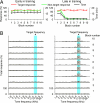Intensive training in adults refines A1 representations degraded in an early postnatal critical period
- PMID: 17895375
- PMCID: PMC1994137
- DOI: 10.1073/pnas.0707348104
Intensive training in adults refines A1 representations degraded in an early postnatal critical period
Abstract
The spectral, temporal, and intensive selectivity of neurons in the adult primary auditory cortex (A1) is easily degraded in early postnatal life by raising rat pups in the presence of pulsed noise. The nonselective frequency tuning recorded in these rats substantially endures into adulthood. Here we demonstrate that perceptual training applied in these developmentally degraded postcritical-period rats results in the recovery of normal representational fidelity. By using a modified go/no-go training strategy, structured noise-reared rats were trained to identify target auditory stimuli of specific frequency from a set of distractors varying in frequency. Target stimuli changed daily on a random schedule. Consistent with earlier findings, structured noise exposure within the critical period resulted in disrupted tonotopicity within A1 and in degraded frequency-response selectivity for A1 neurons. Tonotopicity and frequency-response selectivity were normalized by perceptual training. Changes induced by training endured without loss for at least 2 months after training cessation. The results further demonstrate the potential utility of perceptual learning as a strategy for normalizing deteriorated auditory representations in older (postcritical-period) children and adults.
Conflict of interest statement
The authors declare no conflict of interest.
Figures





Similar articles
-
Developmentally degraded directional selectivity of the auditory cortex can be restored by auditory discrimination training in adults.Behav Brain Res. 2011 Dec 1;225(2):596-602. doi: 10.1016/j.bbr.2011.08.033. Epub 2011 Aug 30. Behav Brain Res. 2011. PMID: 21893102
-
Auditory discrimination training rescues developmentally degraded directional selectivity and restores mature expression of GABA(A) and AMPA receptor subunits in rat auditory cortex.Behav Brain Res. 2012 Apr 15;229(2):301-7. doi: 10.1016/j.bbr.2011.12.041. Epub 2012 Jan 26. Behav Brain Res. 2012. PMID: 22306199
-
Environmental noise retards auditory cortical development.Science. 2003 Apr 18;300(5618):498-502. doi: 10.1126/science.1082163. Science. 2003. PMID: 12702879
-
Lifelong plasticity in the rat auditory cortex: basic mechanisms and role of sensory experience.Prog Brain Res. 2011;191:119-31. doi: 10.1016/B978-0-444-53752-2.00009-6. Prog Brain Res. 2011. PMID: 21741548 Review.
-
New perspectives on the auditory cortex: learning and memory.Handb Clin Neurol. 2015;129:117-47. doi: 10.1016/B978-0-444-62630-1.00007-X. Handb Clin Neurol. 2015. PMID: 25726266 Review.
Cited by
-
Age-related neural dedifferentiation in the motor system.PLoS One. 2011;6(12):e29411. doi: 10.1371/journal.pone.0029411. Epub 2011 Dec 22. PLoS One. 2011. PMID: 22216274 Free PMC article.
-
Neural prostheses and brain plasticity.J Neural Eng. 2009 Dec;6(6):065008. doi: 10.1088/1741-2560/6/6/065008. Epub 2009 Oct 23. J Neural Eng. 2009. PMID: 19850976 Free PMC article. Review.
-
Vascular changes and brain plasticity: a new approach to neurodegenerative diseases.Am J Neurodegener Dis. 2012;1(2):152-9. Epub 2012 Jul 23. Am J Neurodegener Dis. 2012. PMID: 23383389 Free PMC article.
-
Brain plasticity and motor practice in cognitive aging.Front Aging Neurosci. 2014 Mar 10;6:31. doi: 10.3389/fnagi.2014.00031. eCollection 2014. Front Aging Neurosci. 2014. PMID: 24653695 Free PMC article. Review.
-
Environmental acoustic enrichment promotes recovery from developmentally degraded auditory cortical processing.J Neurosci. 2014 Apr 16;34(16):5406-15. doi: 10.1523/JNEUROSCI.5310-13.2014. J Neurosci. 2014. PMID: 24741032 Free PMC article.
References
Publication types
MeSH terms
Grants and funding
LinkOut - more resources
Full Text Sources
Medical

